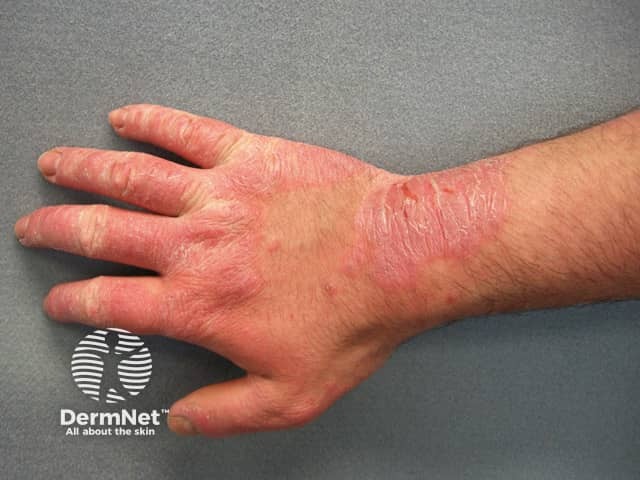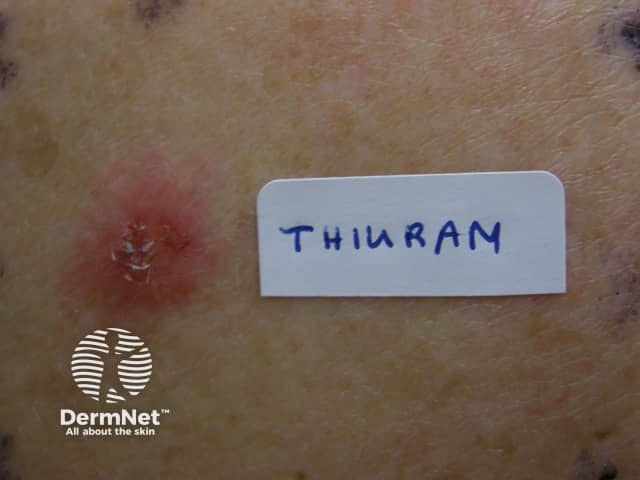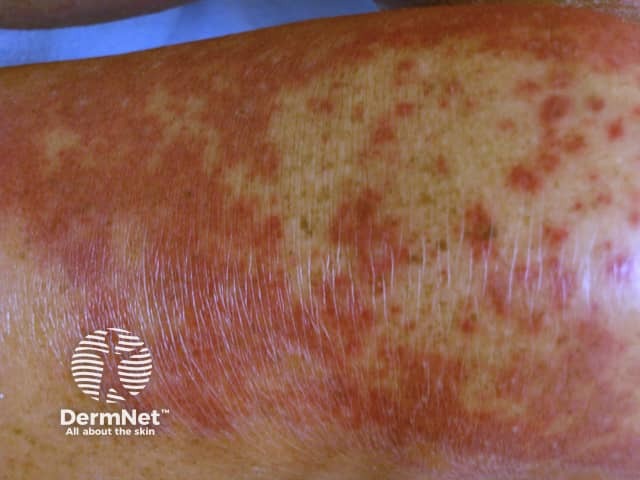Main menu
Common skin conditions

NEWS
Join DermNet PRO
Read more
Quick links
Contact dermatitis — extra information
What is contact dermatitis?
Contact dermatitis (also called contact eczema) refers to a group of skin disorders in which the skin reaction is due to direct contact with the causative agent. The term dermatitis implies that the outside layers of skin are affected. It can be acute (a single episode) or chronic (persistent). Dermatitis is nearly always itchy.
Contact dermatitis includes several entities.
- Chemical burns
- Irritant contact dermatitis
- Allergic contact dermatitis
- Contact stomatitis and contact cheilitis
- Protein contact dermatitis
- Systemic contact dermatitis
Contact dermatitis is sometimes mixed in origin, particularly when it is resulting in hand dermatitis. Contact dermatitis is the most common cause of occupational skin disease, and is particularly common in cleaners, healthcare workers, food handlers and caterers, and hairdressers. It can even occur in people using computers (computer mouse dermatitis).

Allergic contact dermatitis to rubber

Allergic contact dermatitis to rubber

Dermal contact dermatitis
What does contact dermatitis look like?
The appearance of contact dermatitis is highly variable. It may affect any area of the body and may be any shape (linear, round, polygonal, irregular). Affected skin may have any of the following features.
- Redness (erythema)
- Blisters that are small (vesicles) or large (bullae)
- Swelling (oedema)
- Dryness or scaling
- Cracks (fissuring)
- Lichenification (thickened, lined skin)
- Pigmentation increased (hyperpigmentation) or reduced (hypopigmentation).
Secondary changes may include:
- Scratch marks (excoriation)
- Crusting (due to ooze)
- Pustules (due to bacterial infection).
How is the diagnosis of contact dermatitis made?
Contact dermatitis is usually identified after taking a careful history.
- The rash is eczematous (surface skin changes such as blistering, dryness, peeling and redness)
- The rash has occurred in an area in contact with the putative cause
- The rash has not occurred in sites that are not in contact with this agent
- It may or may not affect all areas of skin in contact with the agent
- Contact dermatitis is usually asymmetrical in distribution, e.g. one hand more severely affected than the other
The various forms of contact dermatitis may appear similar to each other. They may be distinguished by the following features.
- Chemical burn occurs after a single exposure to a toxic agent such as a strong acid or alkali. Only the skin in contact with the chemical is affected.
- Irritant dermatitis may occur after a single exposure but more commonly follows repetitive exposure to an irritant such as frictional injury, soaps and detergents, excessive immersion in water, mild acids and alkalis, solvents. At least at first, only the skin in contact with the irritant is affected and generalised spread of dermatitis is uncommon. Irritant dermatitis is more common in atopics (often people with a previous history of atopic eczema), sensitive skin and other conditions in which skin barrier function is compromised.
- Allergic dermatitis usually occurs unexpectedly after the allergen was previously tolerated. Afterwards, contact with even minute amounts of the allergen cause dermatitis on the exposed sites. The dermatitis may spread beyond the borders of direct contact with the allergen, and may spread more widely (autoeczematisation).
- Contact stomatitis and contact cheilitis affect the inside of the mouth and lips respectively.
- Protein contact dermatitis results from contact with foods (such as meat or potatoes). Immediate contact urticaria is followed by acute and sometimes chronic dermatitis in the same site.
- Systemic contact dermatitis follows ingestion of a substance that has previously caused allergic contact dermatitis. It results in a symmetrical rash, often affecting flexures (e.g. baboon syndrome), and may generalise. Systemic contact dermatitis is rare.
Patch tests are important to identify contact allergens in any severe or persistent case of contact dermatitis. An Open application test may also be recommended.
How is contact dermatitis treated?
Once the causes of contact dermatitis are identified, it is important to avoid direct contact with them. But whatever the cause of the dermatitis, the barrier function of the skin has been damaged and further dermatitis may occur if exposed to irritants.
- Avoid soap – use a pH-balanced cleanser suitable for sensitive skin
- For treating and preventing hand dermatitis, wear appropriate gloves to protect against friction, detergents, soil, plants, paints, diesel etc.
- Dry skin carefully after washing
The rash can be treated with a short course of topical corticosteroid creams. Apply emollients frequently while the rash is active and for some weeks afterwards as the normal skin barrier function is restored.
Severe contact dermatitis may be treated with a short course of systemic corticosteroids, e.g. oral prednisone. Occasionally, for chronic contact dermatitis, phototherapy may be tried, or immunosuppressive agents such as methotrexate, ciclosporin or azathioprine may be prescribed.
References
- Guidelines for care of contact dermatitis. J Bourke, I Coulson, J English, BJD, Vol. 160, No. 5, May 2009 (p946–54). Journal
- Diagnosis, management and prevention of occupational contact dermatitis: concise guidelines. — Royal College of Physicians, British Association of Dermatologists, British Occupational Health Research Foundation, Faculty of Occupational Medicine, Health and Work Development Unit and NHS Plus. Concise guidance to good practice series, No 13. London RCP, April 2011
On DermNet
- Dermatitis
- Chemical burns
- Irritant contact dermatitis
- Allergic contact dermatitis
- Contact allergens
- Plant dermatitis
- Plants that cause skin problems
- Eyelid contact dermatitis
- Computer mouse dermatitis
- Occupational dermatitis among construction workers
- Occupational skin disorders in homemakers
- Blistering skin conditions
- Emollients and moisturisers
Other websites
- Allergic Contact Dermatitis — Medscape Drugs & Diseases
- Irritant Contact Dermatitis — Medscape Drugs & Diseases
- Contact dermatitis — MedlinePlus
- Patient information: Contact dermatitis (including latex dermatitis) (Beyond the Basics) — UpToDate (for subscribers)
- Contact dermatitis — American Academy of Dermatology
